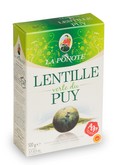Trescarte’s commitments
Our environmental commitment
Our involvement in the agricultural sector motivates us to limit our impact on the environment.
- We do not use water in our production cycle
- All green waste is recycled as compost (immature grains, plant residue other than lentils or cereals, etc.).
- Our production equipment is fitted with a dust extraction system.
- Our machines generate no sound nuisance
Certification
Since 1959, product quality and safety are core preoccupations in our production process. Our facilities are certified IFS in order to meet the quality requirement of our partners around the World.
Interesting facts
In the 1930s, the identity of the Le Puy green lentil was often copied in order to deceive lovers of this coveted lentil, in particular in Germany and Russia. To protect itself, the sector launched in 1934 a petition for the recognition of the designation of origin Lentille Verte du Puy. On January 17, 1935, the civil court of Le Puy ruled that the designation Lentille Verte du Puy represented a designation of origin, and not a simple generic term… The lentil subsequently received the French AOC label in 1961 (Appelation d’Origine Contrôlée), and the European PDO label in 2008 (Protected Designation of Origin).
«La Ponote» is Trescarte’s registered trademark for its PDO Le Puy green lentils. The trademark itself is existing since 100 years old… and the term ‘La Ponote » first refers to the female inhabitants of Le Puy-en-Velay. As for the men, they are called « Les Ponots ».
The « Ponote » woman featured on Trescarte’s packaging PDO Le Puy green lentil is a lacemaker: indeed, the town of Le Puy is renowned for the delicacy and beauty of the lace that these genuine artists still produce today…
Eating lentils on News Year’s Day is a widespread tradition in southern France and in Italy, and symbolizes money and prosperity for the New Year!
Why is the cathedral in Le Puy-en-Velay built on Mount Anis ?
Legend has it that a woman sitting on a stone called the fever stone (Pierre des Fièvres) was miraculously cured.
In exchange, in a dream this woman received the command to ask Saint George, the bishop of Reussium, to build a church on Mount Anis. The legend says that a deer traced the limits of the building in the snow… The Pierre des Fièvres can still be seen in the Saint-Crucifix chapel in the Le Puy cathedral.




